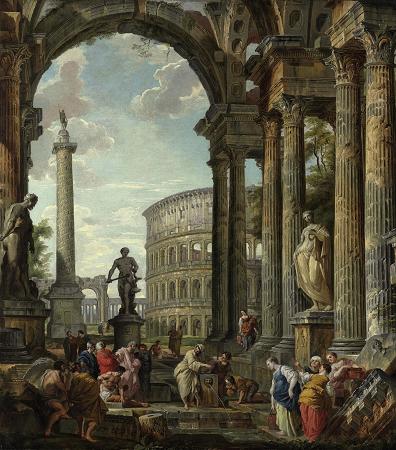Trajan's Column (-113). Trajan's Column is a Roman triumphal column in Rome, Italy, that commemorates Roman emperor Trajan's victory in the Dacian Wars. It was probably constructed under the supervision of the architect Apollodorus of Damascus at the order of the Roman Senate. It is located in Trajan's Forum, built near the Quirinal Hill, north of the Roman Forum. Completed in AD 113, the freestanding column is most famous for its spiral bas relief, which artistically represents the wars between the Romans and Dacians. Its design has inspired numerous victory columns, both ancient and modern. The structure is about 30 metres in height, 35 metres including its large pedestal. The shaft is made from a series of 20 colossal Carrara marble drums, each weighing about 32 tons, with a diameter of 3.7 metres. The 190-metre frieze winds around the shaft 23 times. Inside the shaft, a spiral staircase of 185 steps provides access to a viewing platform at the top. The capital block of Trajan's Column weighs 53.3 tons, which had to be lifted to a height of c. 34 metres. Ancient coins indicate preliminary plans to top the column with a statue of a bird, probably an eagle, but after construction, a statue of Trajan was put in place; this statue disappeared in the Middle Ages. On December 4, 1587, the top was crowned by Pope Sixtus V with a bronze figure of St. Peter, which remains to this day.The column was originally flanked by two libraries, which may have contained Trajan's scroll-written despatches from his Roman-Dacian Wars. Filippo Coarelli suggests that such scrolls are the basis both of the column's design and its spiraling, sculpted narrative. The column shows 2,662 figures, and 155 scenes; Trajan himself appears on the column 58 times. The continuous helical frieze winds 23 times from base to capital, and was in its time an architectural innovation. The design was adopted by later emperors such as Marcus Aurelius. The narrative band expands from about 1 metre at the base of the column to 1.2 metres at the top. The scenes unfold continuously. Often a variety of different perspectives are used in the same scene, so that more can be revealed. The relief portrays Trajan's two victorious military campaigns against the Dacians; the lower half illustrating the first, and the top half illustrating the second. These campaigns were contemporary to the time of the Column's building. Throughout, the frieze repeats standardized scenes of imperial address, sacrifice, and the army setting out on campaign. Scenes of battle are very much a minority on the column, instead it emphasizes images of orderly soldiers carrying out ceremony and construction. The war against Dacia was one of conquest and expansion. Therefore, with the aim of the Dacian Campaigns being the incorporation and integration of Dacia into the Roman Empire as a Roman province, depictions of violent action towards foreign women and children are nonexistent. Wartime violence in general seems to have been downplayed. Some scholars suggest the lack of battle scenes and large number of building scenes is a propaganda constructed specifically for the urban population of Rome, addressing their fear and distrust of the army by depicting its warfare as one with little collateral damage. Key specific events portrayed are the first crossing of the Danube by the Roman legion, Trajan's voyage up the Danube, the surrender of the Dacians at the close of the first war, the great sacrifice by the Danube bridge during the second war, the assault on the Dacian capital, and the death of the Dacian king Decebalus. The two sections are separated by a personification of Victory writing on a shield flanked on either side by Trophies. Great care is taken to distinguish the men and women from both sides of the campaign as well as the ranks within these distinct groups. The scenes are crowded with sailors, soldiers, statesmen and priests, showing about 2,500 figures in all. It also exists as a valuable source of information on Roman and barbarian arms and methods of warfare and costume. The relief shows details such as a ballista or catapult. The precise details create a strong effect of verisimilitude; the designer presents the images as objective historical truth. The emperor Trajan is depicted realistically in the Veristic style, making 59 appearances as the central hero among his troops. The portrayal of the Roman army as relatively gentle may have been designed to support Trajan's image as a man of justice, clemency, moderation, and restraint. Women for the most part occupy and define the margins of the scenes. However, mortal females in Roman state art are so rare, it is remarkable that they are included at all in a war monument.
more...










